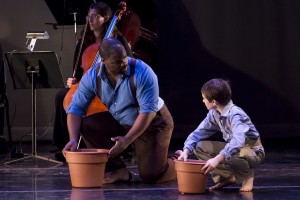 While millions of individuals of African decent were enslaved in the United States, it is alarming that the vast majority of their voices are absent from history. This is especially true in K-12 education; information is largely disseminated through a “top-down” approach that effectively discounts the experiences of the majority of slaves. It is imperative that students learn about the harsh realties of everyday slave life in order to understand injustices and prejudices in contemporary society. However, many students find themselves bored and alienated in the classroom, finding the subject not pertinent to their lives. It is clear that the poignancy of slavery necessitates an educational approach that students find relevant and engaging.
While millions of individuals of African decent were enslaved in the United States, it is alarming that the vast majority of their voices are absent from history. This is especially true in K-12 education; information is largely disseminated through a “top-down” approach that effectively discounts the experiences of the majority of slaves. It is imperative that students learn about the harsh realties of everyday slave life in order to understand injustices and prejudices in contemporary society. However, many students find themselves bored and alienated in the classroom, finding the subject not pertinent to their lives. It is clear that the poignancy of slavery necessitates an educational approach that students find relevant and engaging.
This project seeks to address these issues. “African American History: Uncovered, Transformed, and Disseminated” is a collaborative effort to portray the grossly overlooked experiences of slaves using an innovative, interdisciplinary approach. Inspired by the life of David Drake, it is comprised of two components that link the stage with the classroom. The first is a dance/drama production synthesizing multiple art forms, and the second is a social studies unit based on themes examined in the stage production.
 The integrated arts unit will then be implemented in an eleventh grade social studies classroom of approximately 25-30 students. The efficacy of the unit will be assessed in two ways: improvement in social studies content and artistic knowledge (measured through pre-/posttest scores), and engagement (measured through lesson reflections). To determine a potential correlation between receiving instruction in this unit and improved performance in social studies overall, the scores of these students’ cumulative, year-end assessments will be compared to those of a class in which the unit was not implemented. Based on the literature on arts integration in addition to the findings of previous ArtsBridge projects, it is expected that participation in the unit will be correlated with improved content and artistic knowledge, heightened student engagement, and better overall performance in the content area.
The integrated arts unit will then be implemented in an eleventh grade social studies classroom of approximately 25-30 students. The efficacy of the unit will be assessed in two ways: improvement in social studies content and artistic knowledge (measured through pre-/posttest scores), and engagement (measured through lesson reflections). To determine a potential correlation between receiving instruction in this unit and improved performance in social studies overall, the scores of these students’ cumulative, year-end assessments will be compared to those of a class in which the unit was not implemented. Based on the literature on arts integration in addition to the findings of previous ArtsBridge projects, it is expected that participation in the unit will be correlated with improved content and artistic knowledge, heightened student engagement, and better overall performance in the content area.
Lesson plans and materials will be made available to social studies teachers as part of a professional development package via a website. Teachers may choose to implement the entire unit, specific lessons or certain activities in their classrooms. The package will also include resources on the effectiveness of arts integration, including the results of the pilot study, as well as tools teachers can use to create their own integrated arts lessons or activities. Ultimately, because of the wide-scale dissemination technology allows, this project has the potential to not only affect the 25-30 students participating in the pilot study, but students nationwide.

